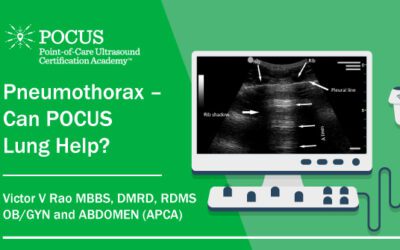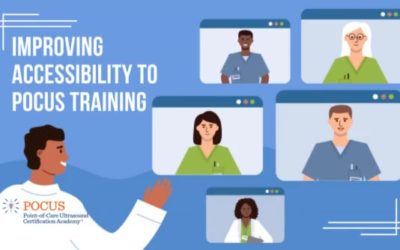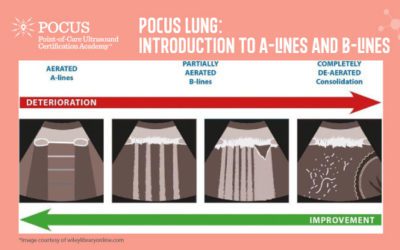Our society is one that lives in perpetual movement. In contrast, COVID-19 has provoked our world to come to a grinding halt. Social distancing, school closings, business closings, and job insecurity are our new norms. Healthcare systems and global leaders are working tirelessly to combat this pandemic. Our hearts go out to our fellow medical providers that are battling in the trenches, relentlessly. Our community continues to show up in the face of this adversity and lives are being saved, thank you.
Point-of-care ultrasound (POCUS) is having a moment of its own in partnership with the heroes of this story. Due to the overloaded state of healthcare venues around our world, agility is key to combating COVID-19. Portable imaging is granting doctors and nurses a method of obtaining swift answers, via POCUS.

With any viral spread as rapid as this one, time is precious. Ordering a CT scan, using a carted ultrasound machine, or sending a patient to a radiology department for a lung examination requires quite a bit more time than POCUS. When a patient is assessed using the three previously stated applications, required deep cleaning becomes a time-zapper. Disinfection can take anywhere from 60 to 120 minutes, which significantly decelerates the exam process. Due to the miniature size of POCUS, disinfection is as simple as applying a sterile probe sheath and wiping down designated smart devices after use.[1]
POCUS is also proving to be effective for patient monitoring. Dr. Yale Tung Chen has gained recognition around the world for his unique perspective in the fight against COVID-19. Dr. Chen contracted the virus while working on the frontlines as the Director of the Ultrasound Division at Hospital Universitario La Paz in Madrid, Spain. He has been utilizing his Butterfly to track the development of COVID-19 in his own body. His pivotal story spotlights how POCUS can serve as a vital weapon in our battle against this pandemic. The POCUS Certification Academy™ had the pleasure of interviewing him for our Focus on POCUS™ podcast.
Since his diagnosis, Dr. Chen has been cleverly tweeting all of his latest discoveries using his Butterfly. He has experienced POCUS to be a powerful alternative for lung ultrasound, stating it is a “great tool to see the lungs.” Since COVID-19 generally infects the peripheral regions of the lungs, POCUS provides efficient imaging of the affected areas.
POCUS has allowed him to predict his symptoms intensifying up to 12-24 hours before taking effect. This insight creates time to make adjustments in his treatment plan, providing a pro-active route for defeating the virus. While he did not experience a reduction in his O2 levels, he does note thickened pleura and clusters of B-lines. His initial onset of symptoms was very mild, noticing a low-grade fever, chills, and headache. Chest pain and shortness of breath did not present itself at all in his case.
In regards to how his hospital is handling the influx, they are experiencing a shortage of supplies such as masks, equipment, and test kits. He advises sending home younger patients that demonstrate a normal lung ultrasound, with mild symptoms, and no risk factors. This recommendation is in light of medical facilities continuing to struggle to cope with the demands of COVID-19.
As we know, for older patients, the major risk is pneumonia induced by COVID-19. For any elderly patient showing lung abnormalities in their ultrasound, accompanied by risk factors, Dr. Chen suggests immediate testing and admission into hospital care.[2] A recently published study titled “Can Lung US Help Critical Care Clinicians in the Early Diagnosis of Novel Coronavirus (COVID-19) Pneumonia?” also highly recommends using POCUS for the investigation of COVID-19 pneumonia.[3]
As of March 31, 2020, the World Health Organization reported 750,890 confirmed cases, with 57,610 of those being new cases in the last 24 hours. For the Americas, statistics show 163,014 confirmed cases, with 20,935 of them being new in the past 24 hours.[4] For many people, we are experiencing something on a scale we have never witnessed before. While COVID-19 is testing humanity’s ability to have faith in our medical system and our world leaders, our medical providers and POCUS are coming to the rescue in more ways than one.
To get the full inside scoop from Dr. Yale Tung Chen’s journey, be sure to listen to our interview with him on the Focus on POCUS™ podcast. In the meantime, stay safe and stay positive. We are all in this together.
References
- (March 20, 2020) Imaging COVID-19 With Point-of-Care Ultrasound (POCUS). Retrieved March 25, 2020 from https://www.itnonline.com/videos/video-imaging-covid-19-point-care-ultrasound-pocus.
- (March 19, 2020) Tracking COVID-19 with Dr. Yale Tung Chen. Retrieved March 24, 2020 from https://www.pocus.org/resources/tracking-covid-19-with-dr-yale-tung-chen/.
- (March 13, 2020) Can Lung US Help Critical Care Clinicians in the Early Diagnosis of Novel Coronavirus (COVID-19) Pneumonia? Retrieved March 25, 2020 from https://pubs.rsna.org/doi/10.1148/radiol.2020200847.
- (March 26, 2020) Coronavirus disease (COVID-2019) situation reports. Retrieved March 26, 2020 from https://www.who.int/emergencies/diseases/novel-coronavirus-2019/situation-reports/.
Looking for additional inspiration? Sign up for our POCUS Post™ newsletter to receive monthly tips and ideas.
























